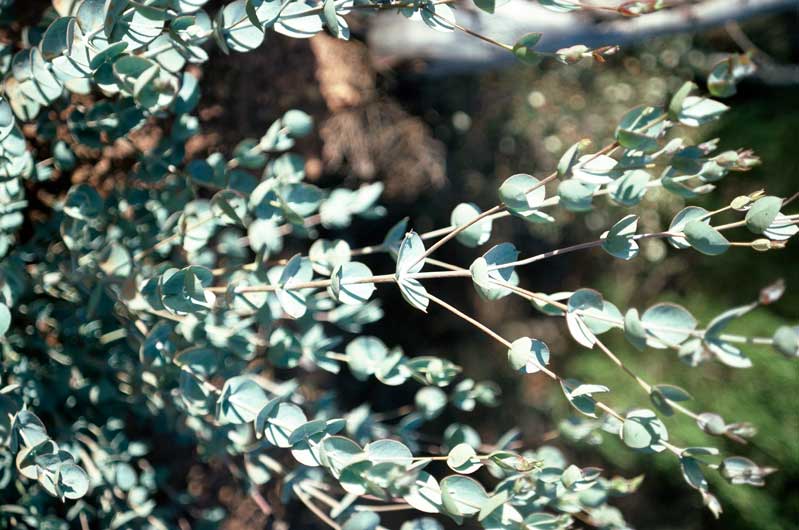Eucalyptus Albida on:
[Wikipedia]
[Google]
[Amazon]
''Eucalyptus albida'', commonly known as the white-leaved mallee, is a mallee that is 


endemic
Endemism is the state of a species being found in a single defined geographic location, such as an island, state, nation, country or other defined zone; organisms that are indigenous to a place are not endemic to it if they are also found else ...
to the south-west
The points of the compass are a set of horizontal, radially arrayed compass directions (or azimuths) used in navigation and cartography. A compass rose is primarily composed of four cardinal directions—north, east, south, and west—each se ...
of Western Australia
Western Australia (commonly abbreviated as WA) is a state of Australia occupying the western percent of the land area of Australia excluding external territories. It is bounded by the Indian Ocean to the north and west, the Southern Ocean to th ...
. It has smooth white or greyish brown bark, lance shaped adult leaves, and flowers in groups of between seven and eleven. The flowers are creamy white and the fruit are hemispherical to cone-shaped. The juvenile leaves that are often retained on mature plants are arranged in opposite pairs, egg-shaped to heart-shaped and bluish grey.


Description
''Eucalyptus albida'' is a mallee that typically grows to a height of and has smooth white or greyish brown bark. The leaves on young plants are arranged in opposite pairs, egg-shaped to heart-shaped, the same shade of bluish grey on both sides, long and wide. Juvenile leaves are often present on mature plants. The adult leaves are lance-shaped, glossy dark green on both sides, long and wide. The flower buds are arranged on a branchinginflorescence
An inflorescence is a group or cluster of flowers arranged on a Plant stem, stem that is composed of a main branch or a complicated arrangement of branches. Morphology (biology), Morphologically, it is the modified part of the shoot of sperma ...
, each branch with groups of between seven and eleven buds on a peduncle long, each bud on a pedicel
Pedicle or pedicel may refer to:
Human anatomy
*Pedicle of vertebral arch, the segment between the transverse process and the vertebral body, and is often used as a radiographic marker and entry point in vertebroplasty and kyphoplasty procedures
...
long. The buds are spindle-shaped with a conical, blunt-tipped operculum long, about the same length as the floral cup. The flowers are creamy white. Flowering occurs between November and January and the fruit is hemispherical or cone-shaped, long and wide.
Taxonomy
''Eucalyptus albida'' was first formally described in 1925 byJoseph Maiden
Joseph Henry Maiden (25 April 1859 – 16 November 1925) was a botanist who made a major contribution to knowledge of the Australian flora, especially the genus ''Eucalyptus''. This botanist is denoted by the author abbreviation when citing ...
and William Blakely
William Faris Blakely (November 1875 – 1 September 1941) was an Australian botanist and collector. From 1913 to 1940 he worked in the National Herbarium of New South Wales, working with Joseph Maiden on ''Eucalyptus'', Maiden named a ''red ...
and the description was published in '' Journal and Proceedings of the Royal Society of New South Wales''. The type specimen was collected near Harrismith
Harrismith is a large town in the Free State province of South Africa. It was named for Sir Harry Smith, a 19th-century British governor and high commissioner of the Cape Colony. It is situated by the Wilge River, alongside the N3 highway, ab ...
by Charles Gardner. The specific epithet (''albida'') is taken from the Latin
Latin (, or , ) is a classical language belonging to the Italic branch of the Indo-European languages. Latin was originally a dialect spoken in the lower Tiber area (then known as Latium) around present-day Rome, but through the power of the ...
word ''albidus'' meaning "whitish" in reference to the colour of the juvenile leaves.
Distribution
White-leaved mallee grows in sand, often with gravel and over laterite, inkwongan
Kwongan is plant community found in south-western Western Australia. The name is a Bibbelmun (Noongar) Aboriginal term of wide geographical use defined by Beard (1976) as
Kwongan has replaced other terms applied by European botanists such as ...
and shrubland. It is found from Tammin and Narrogin east to Hyden and Ravensthorpe Ravensthorpe may refer to any of the following places.
England
*Ravensthorpe, Dewsbury in West Yorkshire
**Ravensthorpe railway station, Dewsbury
*Ravensthorpe, Northamptonshire
*Ravensthorpe, Peterborough in Cambridgeshire
*Ravensthorpe, an histor ...
with a disjunct population near Badgingarra.
Conservation
This eucalypt is classified as "not threatened" by the Western Australian GovernmentDepartment of Parks and Wildlife
The Department of Parks and Wildlife (DPaW) was the department of the Government of Western Australia responsible for managing lands described in the ''Conservation and Land Management Act 1984'' and implementing the state's conservation and e ...
.
Uses
The juvenile leaves orcoppice
Coppicing is a traditional method of woodland management which exploits the capacity of many species of trees to put out new shoots from their stump or roots if cut down. In a coppiced wood, which is called a copse, young tree stems are repeate ...
regrowth of this species is used by florists as a filler in dried flower arrangements and is referred to as rustle gum. The plant is drought and frost resistant in cultivation.
See also
* List of ''Eucalyptus'' speciesReferences
{{Taxonbar, from=Q15396092 Eucalypts of Western Australia Trees of Australia albida Myrtales of Australia Plants described in 1925 Taxa named by Joseph Maiden Taxa named by William Blakely